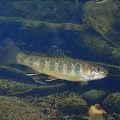Fly Fishing Jazz: “Good Bait”

Wikipedia image
THE PERMIT CRUISED into the shallows, and I knew right away it was big, because it glimmered under the surface like a shiny trash can lid. Florida flats guide Bill Curtis was on the poling platform; he just pointed to make sure I had my bearings, not saying a word.
I made what I thought was the perfect cast—a 60-footer that plopped the crab fly two feet in front of the fish, and just a bit beyond. As I started skipping (a bit too quickly) the crab into its feeding zone, the permit spun around and finned off into oblivion.
Curtis had already climbed down on deck, grumbling all the way.
“What happened? I thought I led that fish perfectly!” I asked.
“Permit aren’t used to their bait attacking them,” he answered, and he wasn’t smiling.
Therein I learned the greatest lesson ever taught on fly presentation: Make the fly behave like real bait, the way it would naturally act in its environment, even if that runs counter to your instincts as an angler.
The trout angler spends so much time mimicking hapless bugs in currents, “spoon feeding” flies to trout with perfect dead drifts, because that’s often exactly what is required. In saltwater fishing, we forget that crabs don’t normally commit suicide by running toward the business end of a predatory fish.
Same with baitfish in the river. You might be inclined to “spoon feed” Autumn Splendors and Muddler Minnows to brown trout holding against the bank, but I think the more panicked you make that fly look, the better off you are.
Often times you want to cast just close enough for the fly to say, “here I am,” and then start the “here I go” as quickly as possible.
Caddis skitter, so your fly should sometimes do the same. Mice fall in the river and panic, so make your mouse fly look scared to death.
Granted, many of us are fly anglers and not bait fishers because we tout a “more refined” method for attracting the bite. But it’s still absolutely critical to make your flies behave like natural forage. With due respect to the late John Coltrane, the more you think of your fancy flies as “Good Bait,” the more fish you will catch—in the salt and on the river.











